Do you only think of sushi and stir fry when you think of soy sauce? If sushi night is the only time you bust out your bottle of this sauce, you’re missing out on a ton of flavor opportunities. By working soy sauce into your regular ingredient rotation, you can give your meals the flavor boost you’ve been craving.
To help you become a soy sauce expert, we’ll explain what soy sauce is generally used for, what to eat with soy sauce, and some lesser-known soy sauce uses. Then, get inspired with a few specific recipes with soy sauce.
Table of Contents
What Is In Soy Sauce?
What Is Soy Sauce Used For?
What Can I Make With Soy Sauce?
7 Unique Recipes Using Soy Sauce
Use SAN-J Tamari Soy Sauce to Create Your Next Culinary Masterpiece
What Is In Soy Sauce?
Soy sauce is packed with umami flavor from fermented soybeans and contains a substantial amount of salt which makes it the perfect condiment for just about anything that needs seasoning. Overall, soy sauce provides a dish with salt, umami and a hint of sweetness, making it suitable for a wide variety of recipes. For those with dietary restrictions, you can use low-sodium soy sauce or Tamari, which is the Japanese version of soy sauce that contains no wheat and is typically gluten-free.
Once you’ve found the right soy sauce for you, you’ll be ready to start adding it to all your recipes. You can begin by slowly adding soy sauce a dash at a time to any dish that could benefit from a bit of complexity.
What Is Soy Sauce Used For?
Soy sauce is an extremely versatile ingredient that can be used as a table condiment or added to dishes during cooking for extra flavor. The ingredient is made from fermented soybeans, giving it a strong umami taste from the fermentation process. Umami is the fifth basic taste, placing it alongside sweet, sour, bitter and salty. Soy sauce offers a unique taste that can’t be created by mixing other flavors.
The taste of umami can be generally described as savory. It is that deep, rich flavor that comes with foods such as meat, cheese, tomatoes, mushrooms and seafood. Umami is a complex taste that adds an extra layer of flavor to whatever dish it’s in.
These are the three primary properties of umami taste:
- Spreading across the tongue: Umami coats the tongue and is experienced all across the taste buds.
- Lingering: The taste of umami lingers and has a noticeable effect on the aftertaste of food.
- Promoting salivation: Umami prompts the mouth to produce more saliva than the other basic tastes do.
You might already know about cooking with soy sauce in applications like:
1. Meats
Soy sauce has a ton of flavor benefits to offer meat. Essentially, soy sauce will help your meat taste meatier. Because protein already has a considerable amount of umami flavor, adding soy sauce can make it a savory sensation. Soy sauce can also help your piece of protein take on an appetizing burnished, caramelized color.
Adding soy sauce to your meat is easy, too. If you’re prepping a piece of pork, beef, chicken or fish in a wet marinade, all you have to do is pour a bit of soy sauce into the mix. The ingredient will do wonders to balance out the sharpness of the acidic elements of your marinade, such as vinegar or citrus.
2. Vegetables
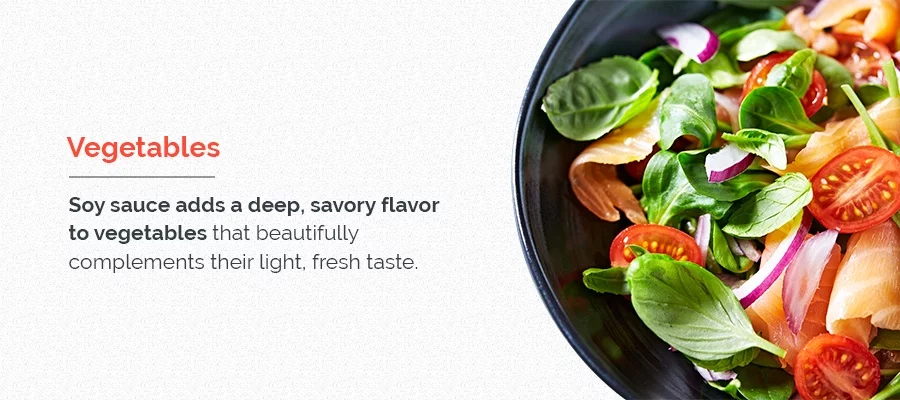
Soy sauce adds a deep, savory flavor to vegetables that beautifully complements their light, fresh taste. Mixing a few drops of soy sauce into a vinaigrette and using it as a salad dressing will give a simple green salad multiple layers of richness and flavor complexity. Just make sure to add the soy sauce before any other seasonings so you avoid over-seasoning your salad.
Soy sauce can also enhance cooked veggies. Tossing some vegetables in soy sauce, spices and cooking oil before roasting them will encourage better browning and give them an umami boost much like it does for meat. Try drizzling a bit of soy sauce into the pan when you’re deglazing caramelized onions for a savoriness you need to taste to believe.
3. Soups and Stews
Ever been disappointed by a thin, tasteless broth? You never have to worry about dull soups and stews again when you add soy sauce to the recipe. Seasoning your broth with a touch of soy sauce will give the soup a richness that brings out its inherent flavors. The ingredient goes especially well with thick stews and other meaty braises because it adds another layer of depth and complexity to an already savory dish.
What Can I Make With Soy Sauce?
Because soy sauce’s saltiness and umami flavor make it such a versatile ingredient, you can use it to whip up a seemingly endless list of culinary creations. Here are 15 things to eat with soy sauce in the kitchen:
1. Use It as a Salt Substitute
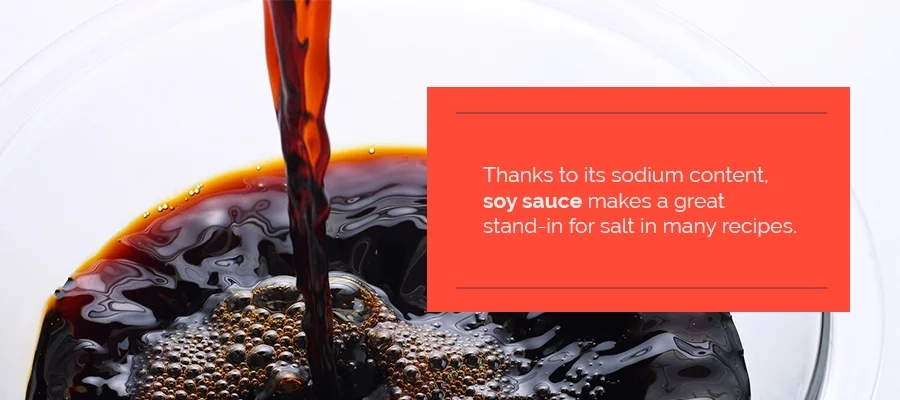
Thanks to its sodium content, soy sauce makes a great stand-in for salt in many recipes. Using soy sauce in place of salt can elevate your cooking game by bringing more to a dish than mere saltiness. The fermented product’s umami-rich flavoring gives dishes an extra depth and deeper color than salt would. Next time you go to add a sprinkle of salt, opt for a splash of soy sauce instead.
2. Turn It Into a Marinade
Soy sauce is a key ingredient for a fast and easy meat marinade. From steaks and pork chops to chicken breasts and salmon fillets, nearly any type of meat can benefit from marinating in a bit of soy sauce. You can either use straight-up soy sauce as your marinade or mix it with other ingredients, such as garlic, fresh herbs, apple cider vinegar or citrus zest. Seasoning soy sauce can create a more complex marinade. Check out our savory Honey & Tamari Chicken recipe that creates a marinade using our gluten-free tamari soy sauce.
If you do decide to marinate your meat in soy sauce, only do so for about half an hour. Any longer and the meat may become too salty. Blot the meat dry before sautéing or searing it to prevent any splattering or sticking.
3. Mash It Into a Compound Butter
Just as everything is better with butter, every butter is better with soy sauce. Combining soy sauce and softened butter creates a savory, umami-flavored spread that’s easy to melt over vegetables, resting meats or grains to instantly give them a delectable sauce. From swirling the compound butter into rice or noodles to sautéing ingredients in it to give basic recipes an extra kick, there are limitless uses for soy sauce butter.
Mix some soy sauce into room temperature butter — start with a quarter of a cup per pound of butter and adjust to taste. Then roll it into a log in plastic wrap and place it in the freezer. Once the compound butter log is frozen solid, you can slice off coins to cook with as needed.
4. Add It to Gravy
If you want a quick and easy way to add rich flavor to your gravy, stir in a splash of soy sauce. It won’t take much to make your gravy’s flavor pop, so start by adding in just a touch of soy sauce, taste-testing the gravy and adding more as needed.
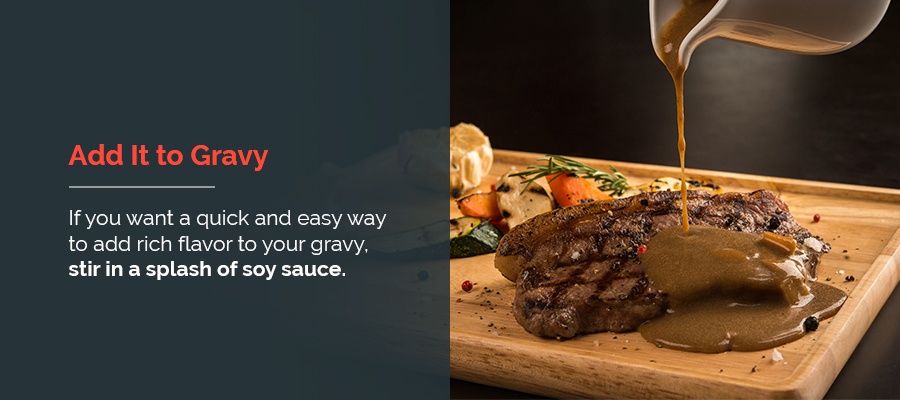
5. Make a Savory Pasta Sauce With It
Soy sauce is a star pasta sauce ingredient. You need little more than soy sauce, sesame oil and some scallions to create a mouth-watering stir fry sauce. The soy sauce gives the noodles a delicious, salty umami taste while the sesame oil deepens the dish’s flavors and allows the sauce to cling to the pasta better.
Although soy sauce is traditionally used to make Asian-inspired noodle dishes, you can add a dash of it to other types of pasta sauces to give them a flavor boost. For instance, including a bit of soy sauce in a Bolognese brings out the natural umami flavor of the tomatoes and meat. Stirring some soy sauce into a classic white sauce like béchamel will also elevate its flavor profile by enhancing the nuttiness and creamy texture.
6. Create an All-Purpose Dipping Sauce
Of course, soy sauce is an excellent dipping sauce all on its own. But when you combine soy sauce with ingredients like fresh ginger, rice wine and scallions, you can concoct a show-stopping sauce. When you create your dipping sauce, let the mixture sit for a while to meld the flavors. On the off-chance you have any leftover dipping sauce, you can store it in your refrigerator for days in an airtight container.
7. Poach Poultry
You can easily poach chicken in a soy sauce and water mixture to whip up a delicious low-fat meal. Pour about a cup of soy sauce into the pot for each liter of water before submerging the chicken in the mixture and turning up the heat. Add some extra seasonings like lime juice or ginger to the water to give the meat a bit of extra flavoring.
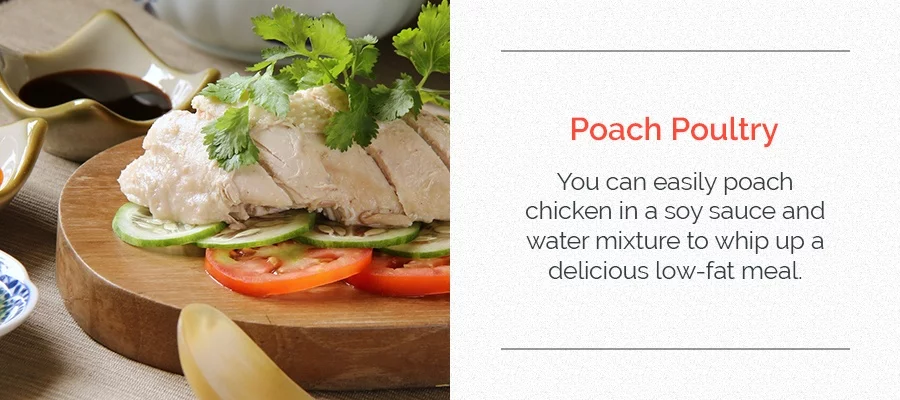
8. Baste a Roast
You can use soy sauce as a delicious baste for red meats, such as a beef roast or ribs. Along with giving the meat some added umami taste, the soy sauce will turn the dish a lovely mahogany color. To baste the meat, brush the soy sauce onto the beef before roasting and throughout the cooking process to ensure extra flavor and even browning.
If you want to jazz up your plain soy sauce baste a bit, mix it with orange marmalade to give it a burst of citrus flavor. Brush the mixture over the meat the same way you would a regular soy sauce baste until the roast is cooked through.
9. Make a Miso Glaze
Embrace soy sauce’s Asian roots by combining it with miso to make a mouth-watering Japanese-style glaze. Miso is a traditional Japanese seasoning that also stems from fermented soybeans and gives dishes a deep, salty and savory flavor. Mix miso paste, soy sauce and a bit of honey together to produce a sticky glaze that’s perfect for coating fish, tofu, vegetables and most meats.
10. Boost Your Burgers
Because the umami flavor of soy sauce complements the natural richness of red meat so well, adding soy sauce to your ground meat blend can make your burgers taste gourmet. Simply mash a bit of soy sauce into the burger meat mixture before forming the meat into patties and tossing them on the grill. The result will make your burgers even better than restaurant-quality.
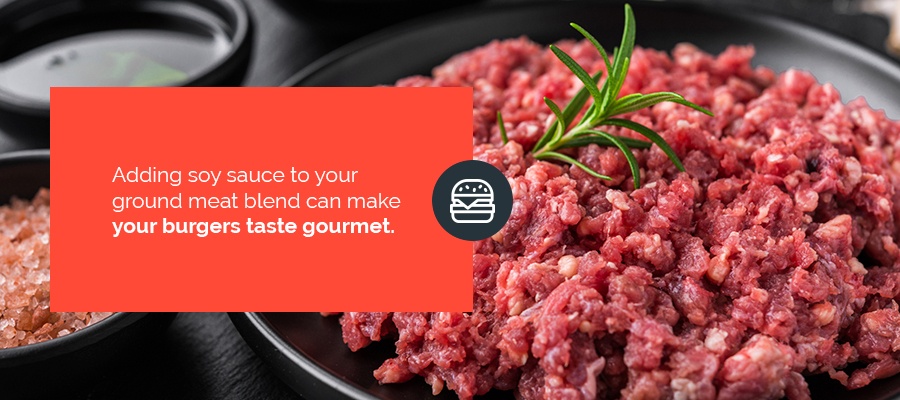
11. Let It Dress up Potatoes
Potatoes are the ultimate side dish to enhance a meal, and nothing punches up potatoes quite like soy sauce. Simmer cubed Yukon Gold potatoes in soy sauce with a bit of sugar and spices like chili pepper flakes to make the perfect accent dish. The soy sauce and spices infuse the potatoes with flavor while they soften and get a nice crisp from the skillet. Be sure to stir the potatoes occasionally throughout the cooking process so they don’t stick to the pan.
12. Stir It Into a Hearty Stew
In some Asian countries, soy sauce is regularly sweetened with sugar to produce a sweet, salty and bold cooking solution. Create your own sweetened version by blending equal parts soy sauce and molasses. Bring the mixture to a boil and simmer it until viscous before allowing it to cool.
This DIY slightly sweet soy sauce is perfect for stirring into a pork stew because the taste brings out the meat’s natural umami flavors. Try adding your sweet soy sauce creation to beef stew, chilis and other soups with red meat as well. You can also use soy sauce instead of salt when making stock, which will lend a deeper flavor to your stews and other dishes.
13. Roast Snacking Nuts
For a tasty and convenient snack, toss a variety of raw, unsalted nuts in soy sauce and chili powder, then roast until golden. The resulting snack mix will be your new favorite treat.
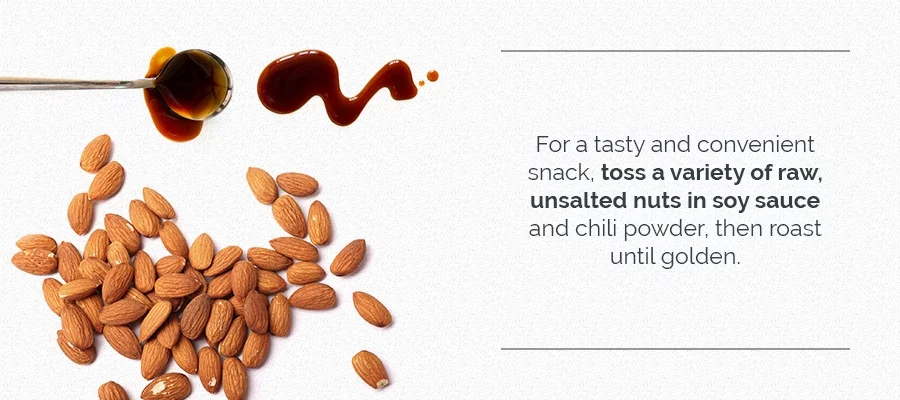
14. Bake With It
Soy sauce excellently complements the yeasty flavor of many doughs. Brush a bit of soy sauce onto either homemade rolled pizza dough or a store-bought pizza base before topping the crust and popping it in the oven. The hint of soy sauce will absorb into the dough as it bakes to bring out its yeasty qualities.
15. Enrich Your Desserts With It
If you really want to wow dinner guests with a sweet grand finale, use soy sauce as your secret dessert ingredient. Thanks to its deep savory flavor, soy sauce can be incorporated into a variety of desserts to balance out their sweetness and give them a more complex flavor profile. For example, pouring a bit of soy sauce into a chocolate brownie mixture before baking can intensify the cocoa flavors.
Adding some soy sauce to other baked goods’ batters, such as cakes or blueberry muffins, can also enhance their sweetness. The ingredient can also complement frozen desserts. Mixing just a dash of soy sauce into softened store-bought vanilla ice cream before putting it back in the freezer will bring out the butterscotch flavor of the frozen treat.
7 Unique Recipes Using Soy Sauce
Now that you have a general idea of what types of delicious dishes you can use soy sauce to create, start experimenting in the kitchen with specific recipes. If you know how to use your soy sauce right, you can sneak the condiment into each dish you serve, from appetizers to desserts. Your dinner guests will never suspect that soy sauce is what makes the flavors in your dishes unforgettable.
To get your creative juices flowing, here are seven recipes that use soy sauce in a surprising way:

1. Creamy Asparagus and Pea Soup
On its own, a vegetable puree soup like pea soup can be a bit bland. This creamy asparagus and pea soup recipe solves that problem by adding SAN-J Tamari Soy Sauce to the broth, which gives the soup a savory, umami-rich flavor. While the soy sauce deepens the soup’s flavor, the star ingredients of asparagus, baby peas, leeks and lemon juice keep the soup tasting fresh and light overall.
Along with elevating the soup’s flavors, the soy sauce nicely complements the soup’s creamy texture, which comes from the incorporation of coconut milk. Beginning a dinner with this refreshing soup is a great way to set the tone for a delicious meal.
2. Bacon-Wrapped Stuffed Dates
If you’re looking for an appetizer that’s a bit richer than soup, these bacon-wrapped stuffed dates are the perfect find. The addition of savory SAN-J Tamari Soy Sauce to this decadent dish perfectly melds with the sweet Medjool dates, salty bacon and tangy goat cheese. Crunchy chopped pecans are the perfect finish to complement the crispy bacon, chewy dates and smooth, creamy goat cheese.
3. Roasted Spring Vegetable Cobb Salad
This fresh take on the traditional Cobb salad relies on the savory, salty flavor of SAN-J Tamari Soy Sauce to boost its flavor. The salad recipe uses soy sauce to blend up a delicious sweet and savory dressing and to glaze the radishes, beets, artichoke hearts and asparagus spears. With richer ingredients like turkey bacon and goat cheese to counter the variety of veggies, this Cobb salad is delicious and filling enough to serve as an entrée.
4. Savory Tamari Meatloaf
Meatloaf and soy sauce make the perfect match because the savory taste of the condiment brings out the umami-rich flavors of the meatloaf. To make savory Tamari meatloaf, all you have to do is sauté a few ingredients and toss everything together in a large mixing bowl. Then pop it in the oven for an hour and a half to let the delicious flavors develop. The bold umami flavor of SAN-J Tamari Soy Sauce will do the rest of the work to make your meatloaf taste like fine dining.
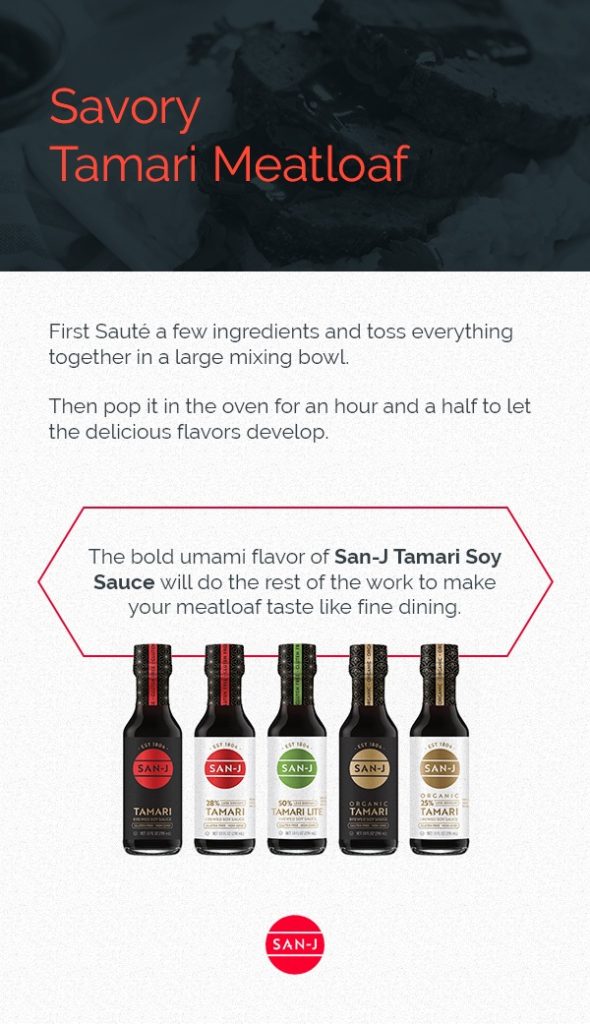
5. Beef Stroganoff
Beef stroganoff presents the perfect opportunity for adding in some umami-enriching soy sauce. SAN-J Tamari Soy Sauce makes this beef stroganoff recipe irresistible by bringing out the savory flavors of the dish’s sauce and complementing the creamy texture. The beef and mushrooms benefit from an umami boost while the extra creaminess allows the sauce to coat the noodles more thoroughly.
6. Chocolate Pecan Pie
A double dose of SAN-J Tamari Soy Sauce makes this chocolate pecan pie recipe the sweetest way to end any dinner. First appearing in the pie filling mixture, soy sauce underscores the chocolate’s rich, earthy flavors to make the pie a more well-rounded dish. Then a splash of soy sauce enhances the homemade whipped cream, which balances out the powdered sugar to create the ideal fluffy topping for this picturesque pie.
7. Tamari Ice Cream With Toasted Pecan Marshmallows
No pie is complete until it’s served à la mode. Take your chocolate pecan pie to the next level by pairing it with this Tamari ice cream with toasted pecan marshmallows recipe. Simply combine your favorite brand of vanilla ice cream with a bit of SAN-J Tamari Soy Sauce, chopped pecans and toasted mini marshmallows to make a frozen delight that belongs beside pecan pie.
Use SAN-J Tamari Soy Sauce to Create Your Next Culinary Masterpiece
Before you start getting creative in the kitchen, you need to make sure you have top-quality soy sauce. At SAN-J, we provide you with a range of soy sauce styles to choose from so you can find the perfect product for your personal tastes and dietary preferences. From dipping sauces to desserts, all your favorite dishes will transform with our soy sauce varieties.
If you’re ready to embrace umami flavors in every meal, order your favorite type of SAN-J Soy Sauce today.
Back to Top
